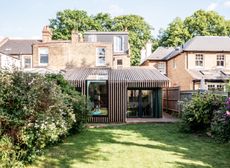Additions
The latest Additions breaking news, comment, reviews and features from the experts at Realhomes
-

Yes, rental renovations are possible — here's how to make them work with your landlord
We often assume rental renovations are a no-go because we don't own the property. Think again! East + Lane's Keyanna Bowen walks us through the how-to's.
By Danielle Valente Published
-

Interior design enthusiast's converted farm home is a showcase for luxe style
Sam Marlow, the founder of Lime Lace, used all her skills to give the renovated period property a signature look
By Alison Jones Published
-

Permitted development rights for extensions: build an extension without planning permission in 2022
Permitted development rights for extensions can allow you to transform your home by extending under permitted development or, without planning permission. Here's everything you need to know.
By Lucy Searle Published
-

Planning permission explained by experts
Learn everything you need to know about planning permission so that you're all prepped for a successful extension or home renovation project.
By Lucy Searle Last updated
-

Real home: Long-term extension project creates the perfect family space
Kate and Adam’s three-pronged renovation took over a decade – but was well worth the wait
By Karen Wilson Last updated
-

Loft conversion stairs: a complete guide to a successful design
The stairs of a loft conversion can be the key to a successful design. Here’s what you need to know
By Sarah Warwick Last updated
-

Real home: knocking through for more space without extending
By knocking together a warren of disjointed rooms, Patsy and Al have created a new hub to their home without needing to extend
By Karen Wilson Last updated
-

How much does a new kitchen cost? Plus, 22 ways to save without compromising on style
What does a new kitchen cost in 2022, and how can you get a room you love for less? Find the answers in our guide
By Laura Crombie Published
-

Small house extension ideas: 16 ways to enhance your living space
Small house extension ideas can boost your home's space and value. If you have little room or a tiny budget, here's how to get your extension – however small – to make a big impact
By Michael Holmes Last updated
-

Double storey extension ideas: 19 ways you could add two storeys
Looking for double storey extension ideas to both floor space and value to your home? These real-life projects will help get your project kickstarted
By Lucy Searle Last updated
-

Double storey extensions: an expert guide to planning, designing and two storey extension costs
Double storey extensions will let you enjoy double the living space of a single-storey extension, while you'll spend less per square metre. From double-storey extension costs to planning permission and more, this is how to get yours right
By Michael Holmes Last updated
-

Side return extensions: 18 ideas to help plan, design and budget for yours
Side return extensions can transform narrow, dark back rooms into airy and open plan spaces. This guide will help you plan, design and budget for yours
By Sarah Warwick Last updated
-

26 house extensions – best house extension ideas for every budget
House extensions offer a cost-efficient and aesthetically pleasing alternative to moving house – be inspired by our roundup of ideas to get your project off the ground
By Michael Holmes Last updated
-

Before and after: a modern kitchen extension with cool industrial touches
We love this contemporary extension – especially that surprise pop of colour…
By Ellen Finch Last updated
-

6 ways to survive renovation stress according to experts
Remodeling can seriously impact well-being. This is how to prepare for the upheaval and make the process more pleasant, according to those who have survived renovation stress themselves...
By Amelia Smith Last updated
-

Extending for under £50,000: 13 top tips for budgeting your home extension
Looking at extending for under £50,000? Making your house bigger needn’t cost the earth. Follow our tips on how to add a £50K extension, and take inspiration from these cost-effective projects
By Lucy Searle Last updated
-

Before and after: an extended 1930s home with quirky creative touches
After a side and rear extension and a full-blown makeover, this house is fit for a family
By Karen Wilson Published
-

How to extend a house – an expert guide to planning your extension
Use this expert guide for an A-Z on how to extend a house successfully. From good planning to design know-how and more – get it right from the start
By Sarah Warwick Last updated
-

House extension suppliers: a sourcebook of the top 50 extension essentials
Locate the best suppliers that are still open for business, for all things house extensions-related. Plus, we've tons of extension planning and design advice too
By Emily Shaw Last updated
-

Plan the kitchen extension of your dreams with our expert guide
Learn everything to do with kitchen extensions so that you can plan and design your own. Here's what you need to know plus 20 brilliant kitchen extension ideas
By Sarah Warwick Last updated
-

Real Homes Stories: See how this couple converted a school bus into a tiny family home for five
This old school bus has been transformed into a functional tiny family home
By Rebecca Knight Last updated
-

This old school bus has been transformed into a stunning tiny home - just wait till you see inside
It has to be seen to be believed
By Millie Hurst Last updated
-

Real home: this interior designer's home is a masterclass in layering texture
Notebooks at the ready – this extended terrace is packed with stylish ideas to steal
By Ellen Finch Published
-

Before and after: this interior designer extended her family home for £50k
All thanks to a combination of skill and imagination
By Ellen Finch Published
-

Renovate or knock down and rebuild: which is more cost-effective?
When does a demolition and rebuild project make more sense than a renovation? Industry experts share their knowledge to help you decide which option is best for you to create your dream home
By Sarah Warwick Last updated
-

A guide to planning a loft conversion in 2022
Get a bigger home without moving by planning a loft conversion to perfection
By Lucy Searle Last updated
-

Do I need planning permission for a loft conversion?
If you like the idea of converting the loft, but wonder if you need an official go-ahead, find the answer right here
By Sarah Warwick Last updated
-

15 single storey rear extension ideas under £100,000
Looking for single storey rear extension ideas under £100,000? Find inspiration for your own home transformation with these beautiful spaces
By Lucy Searle Last updated
-

15 small kitchen extension ideas to help you create that dream open plan space
These small kitchen extension ideas will prove just how much you can do with even the tiniest of spaces
By Hebe Hatton Last updated
